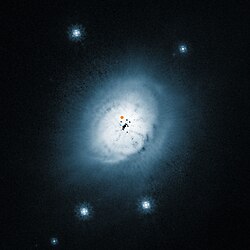HD 100546
 This image from the NASA/ESA Hubble Space Telescope shows a visible light view of the outer dust around the young star HD 100546. The position of the newly discovered protoplanet is marked with an orange spot. The inner part of this picture is dominated by artifacts from the brilliant central star, which has been digitally subtracted, and the black blobs are not real. |
|
| Observation data Epoch J2000.0 Equinox J2000.0 |
|
|---|---|
| Constellation | Musca |
| Right ascension | 11h 33m 25.441s |
| Declination | −70° 11′ 41.24″ |
| Apparent magnitude (V) | 6.698 |
| Characteristics | |
| Spectral type | B9Vne |
| Details | |
| Age | >106 years |
| Astrometry | |
| Proper motion (μ) |
RA: −38.93 ± 0.36 mas/yr Dec.: 0.29 ± 0.38 mas/yr |
| Parallax (π) | 10.32 ± 0.43mas |
| Distance | 320 ± 10 ly (97 ± 4 pc) |
| Other designations | |
| Database references | |
| SIMBAD | data |
| Exoplanet | List of exoplanets| | |
|---|---|---|
| Parent star | ||
| Star | HD 100546 | |
| Right ascension | (α) | 11h 33m 25.441s |
| Declination | (δ) | −70° 11′ 41.24″ |
| Spectral type | B9Vne | |
| Physical characteristics | ||
| Mass | (m) | ~20MJ |
| Radius | (r) |
6.9+2.7 −2.9RJ |
| Temperature | (T) |
932+193 −202K |
| Orbital elements | ||
| Semi-major axis | (a) | 6.5AU |
HD 100546, also known as KR Muscae, is a star 320 LY from Earth. It is orbited by an approximately 20 MJ exoplanet at 6.5 AU, although further examination of the disk profile indicate it might be a more massive object such as a brown dwarf or more than one planet. The star is surrounded by a circumstellar disk from a distance of 0.2 to 4 AU, and again from 13 AU out to a few hundred AU, with evidence for a protoplanet forming at a distance of around 47 AU, and it is also the largest exoplanet discovered with a size around 6.9 RJ.
Estimated to be around 10 million years old, it is at the upper age limit of the class of stars it belongs to—Herbig Ae/Be stars, and also the nearest example to the Solar System.
In 2013, researchers reported that they had found what seems to be a planet in the process of being formed, embedded in the star's large disc of gas and dust. If confirmed, it would represent the first opportunity to study the early stages of planet formation observationally.
Evidence for a planetary companion to HD 100546 was gathered using the UVES echelle spectrograph at the VLT in Chile. This confirms other data indicating a planetary companion. HD 100546 b is probably the largest known exoplanet. The planet's size puts it near the border between a large planet and a brown dwarf.
Coronagraphic optical observations with the Hubble Space Telescope show complex spiral patterns in the circumstellar disk. The causes of these structures remain uncertain. The disk colors are similar to those derived for Kuiper Belt objects, suggesting that the same weathering processes are at work in HD 100546. The disk is fairly flat, consistent with an advanced evolutionary state.
Spectroscopic analysis of mid-IR data taken from OSCIR on the 4 m Blanco Telescope at Cerro Tololo Inter-American Observatory indicates the presence of a small particles (10–18 μm) containing silicates. The material is found at distances out to 17 AU away from the star and has a temperature of approximately 227 K.
...
Wikipedia
